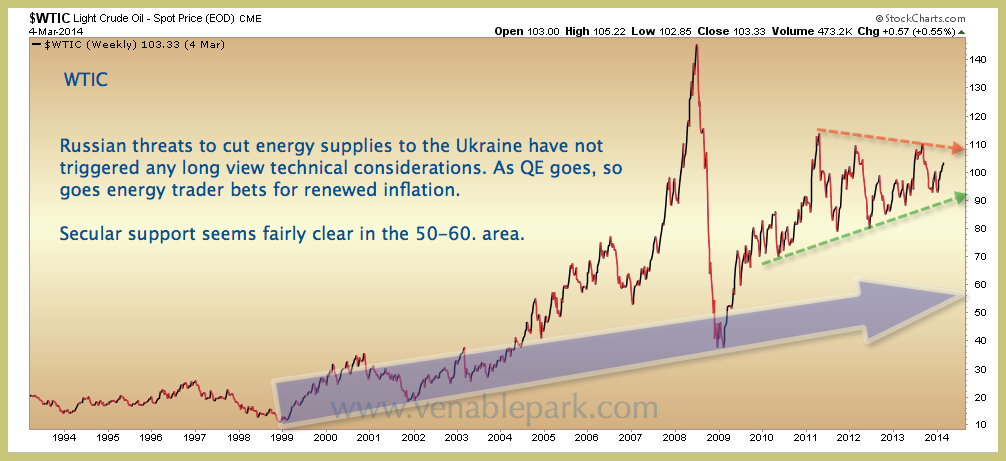The Russian government collects 52% of its revenue from oil and gas taxes, and about 50% of the population are heavily dependent on government transfer payments for their sustenance. Under Putin, the Russian economy has not diversified but remains a nation dependent on petroleum exports.
The trouble is that oil prices above $100 a barrel are considered necessary in order to sustain Russia’s current income needs, and looking forward, a triple-digit-price for oil is suspect. As shown in the chart below, WTI was $12 a barrel in 1999 before the credit bubble boom began, and long term secular support remains in the $55 area, some 50% below current levels.

As Tom Friedman reminded this week: Putin is long oil, but short history: Why Putin doesn’t respect us”
“Putin is now fighting human nature among his own young people and his neighbors — who both want more E.U. and less Putinism. To put it in market terms, Putin is long oil and short history. He has made himself steadily richer and Russia steadily more reliant on natural resources rather than its human ones. History will not be kind to him — especially if energy prices ever collapse.
The cyclical downtrend in the US dollar–starting from the Tech bust in 2000 all the way to the credit/commodities bubble bust in 2008-11–bestowed an embarrassment of oil riches on the Russian government(and other commodity-focused exporters). But times are changing and the price of hydro-carbons appears garishly high today amid a secular backdrop of still weak global demand following the credit bubble bust; the prospects of a strengthening US dollar as QE-belief retreats and Emerging Markets implode; a slowly spreading clamp down on what has been rampant commodity price-fixing by large financial intermediaries the past few years; and against all naysayers–the rise of alternative energy in a hundred different forms. See It’s Time to Drive Russia Bankrupt–Again, for some interesting historical insights on how the strong dollar policy of the 1990’s helped to speed Soviet Russia’s collapse in 1991.
And one more game changer…technological innovation finds inspiration in high fuel prices, pollution and climate change. The cars of the future don’t run on petrol. They charge on solar panels, and they look like this. This technology is already here. Driving one proves an epiphany for even the most committed skeptics.

See another glowing car review here: Tesla will have a 35K car that can go a 1000 miles on a single charge by 2020


